Working with IT outsourcing companies has become a growing industry trend in software development because of its cost-effective and efficient benefits. Within the last two decades, businesses and industry leaders have turned to outsourcing to fuel their operations. This approach allows companies to focus on their core competencies while leveraging external partners' specialized skills and resources.
Aloa has established itself as an industry leader in software development outsourcing. Our team has firsthand experience helping businesses and innovators grow their outsourced teams. Having worked with 10,000+ software development professionals and agencies worldwide, we've seen the value IT outsourcing companies have in today's fast-paced market.
Applying our experience in vetting and working with IT professionals and agencies, we've compiled this guide on today's best IT outsourcing company partners. We'll review each option, outlining their notable strengths so you can make an informed decision when partnering with them. We'll also go through a step-by-step guide on choosing the best partner so you can rest assured you work with the best teams in the industry. By the end of this article, you'll be familiar with leading tech companies that provide outsourcing services and can assist you in achieving your objectives.
Let's get started!
What Are the Different Types of IT Outsourcing Services?
Startups and businesses looking to build their team in partnership with IT outsourcing companies open up a vast pool of potential for themselves. However, it's essential to understand the different IT outsourcing services available. Each type carries with it unique benefits and considerations.
Here are some of the most common types of IT outsourcing services that startups and businesses can leverage to maximize their potential:

IT Outsourcing Services Based on Function
Outsourced IT services based on functions pertain to external providers focusing on specific IT functions or processes. This type of outsourcing allows businesses to delegate particular tasks to experts, ensuring efficient and effective management of those functions.
Here are some common types based on function:
- Application Development and Maintenance: This involves outsourcing software application development, testing, and maintenance. Businesses can leverage the expertise of specialized development teams when creating high-quality apps, performing updates, and fixing bugs to ensure the software remains functional and updated.
- IT Infrastructure Management: Includes managing and maintaining servers, networks, and data centers to ensure the IT infrastructure remains reliable, secure, and efficient.
- Cybersecurity Services: External experts who protect a company's digital assets from cyber threats. These services usually include threat detection, incident response, security audits, and compliance management to provide robust protection against breaches.
- Cloud Computing Services: Involves outsourcing IT infrastructure, platforms, and software to cloud service providers. Businesses can benefit from scalable, flexible, cost-effective solutions by leveraging cloud resources for storage, computing power, and software applications.
- Help Desk Support and Services: Enable businesses to provide reliable tech support to customers and employees. External providers handle troubleshooting, customer queries, and IT support functions to achieve quick and efficient issue resolution.
- Data Analytics and Business Intelligence: Services that focus on data collection, processing, and analysis. These services allow businesses to gain valuable insights and make data-driven decisions that improve performance.
IT Outsourcing Services Based on Hiring Models
IT outsourcing services based on hiring models focus on providing solutions based on the structure and nature of the partnership between a client company and the outsourcing provider. Different hiring models from various IT consultancy providers allow for more flexibility, control, and commitment based on immediate needs.
Here are some common types of IT outsourcing services based on hiring models:
- Project-Based Outsourcing: Entails outsourcing specific projects to external providers who take on the responsibility of completing the project within a defined scope. It is ideal for one-time projects or tasks that require specialized skills not available in-house.
- Dedicated Team Model: Involves hiring IT professionals working exclusively on a client project. The team integrates with the in-house staff and follows the client's long-term projects and ongoing development needs.
- Staff Augmentation: Allows businesses to add external professionals to their internal teams temporarily. An IT outsourcing team extension and manage workloads while offering flexibility and scalability.
- Managed Services: Outsources the management of specific IT functions and processes to a service provider responsible for day-to-day operations. This allows clients to focus on other core business activities.
IT Outsourcing Services Based on Location
IT outsourcing companies offer location-based solutions for client companies depending on their geographical location. These services can be broadly categorized into onshore, offshore, and nearshore outsourcing, each offering distinct benefits and challenges.
Here are the key types of location-based IT outsourcing services:
- Nearshore IT Outsourcing: Involves partnering with service providers in neighboring or nearby countries and offers a balance between cost savings and convenience, as it provides closer time zones, similar cultural aspects, and easier travel for face-to-face meetings. Nearshore outsourcing is ideal for businesses looking to reduce costs while maintaining relatively easy communication and collaboration.
- Offshore IT Outsourcing: Refers to partnering with service providers in distant countries, often on different continents. This model is typically the most cost-effective due to lower labor costs in these regions. However, ensuring successful collaboration requires careful management of time zone differences, cultural barriers, and communication challenges. Offshore outsourcing suits companies looking to significantly reduce operational costs and tap into a vast global talent pool.
- Onshore IT Outsourcing: Also known as domestic outsourcing, it involves partnering with service providers within the same country. This model offers several advantages, including minimal time zone differences, cultural alignment, and easier communication. Onshore outsourcing is often chosen for projects that require frequent and close collaboration, and for companies that prefer to keep operations within their home country.
The top outsourcing companies today offer a mix of skill, experience, and client-focused services. Depending on your specific project or business requirements, you can find an outsourcing partner that aligns closely with your needs.
Each company brings unique strengths and capabilities, allowing businesses to leverage global talent and specialized knowledge to stay competitive and innovative in today's dynamic market.
Let's look at the top 11+ IT outsourcing companies to consider.
11+ Top IT Outsourcing Companies to Partner With in 2024
IT outsourcing companies provide businesses access to specialized skills, cost-effective solutions, and the flexibility to scale operations as needed. Partnering with the right IT outsourcing company in 2024 can significantly enhance efficiency, innovation, and competitiveness. Here are 11+ of the best outsourcing companies to consider partnering with in 2024:
1. Aloa - Top Pick for Outsourcing Company Partner

Aloa specializes in custom software development by linking client companies with the industry's best talent. As a global leader in the software development space, we help businesses build out their IT teams. Whether you are looking to staff multiple IT professionals or work with a team of experienced professionals for product development, Aloa ensures that you are working with the best talent from around the world.
At Aloa, your IT outsourcing experience will be on time, on budget, and done in high quality. Our Account Executives will work with you every step of the way to help you realize the full potential of your project towards staying competitive in fast-paced markets.
Aloa also takes the #1 spot on ClearPick for top software development agencies.
Notable Features of Working with Aloa
- Extensive Partner Network: Aloa has vetted 10,000+ software agencies around the globe, including those in key outsourcing locations like Eastern Europe and Latin America to identify and hire the best IT professionals to link up with clients.
- Rigorous Vetting Process: Every IT professional service provider in our network has undergone a thorough evaluation, ensuring they meet Aloa's stringent quality and proficiency standards.
- Transparent Performance Reports: Aloa ensures consistent updates on the project's progress and lets clients stay informed and confident with every step when it comes to working with IT personnel.
- Dedicated Support System: Aloa offers continuous support throughout the software journey, from initial consultations to project completion. We're here for you.
Aloa Price Plans
Aloa offers cost-saving solutions when working with the industry's best software developers and IT professionals. Our experienced team has worked with small businesses, startups, and individual innovators to help them realize their goals and objectives. Hiring on retainer? Let's chat about monthly discounts. Have a fixed scope of work? Let's get you a detailed estimation. Schedule a call or reach out to [email protected] for a consultation.
2. Innowise - Established Global Outsourcing Expert

Innowise is an established IT outsourcing company based in Warsaw, Poland. Their team is renowned for its ability to provide comprehensive software development and IT consulting services. As an established industry leader, their 17 years in IT consulting caters to IT and non-IT organizations. Innowise sets its goals to empower businesses through digital transformation, leveraging the latest trends and technologies to make it happen.
With a team of 1,600 highly skilled specialists, they craft innovative software solutions using the latest industry tech like React, Angular, JavaScript, Node.js, .Net, Python, PHP, and more. Additionally, Innowise harnesses IT talent from Central and Eastern Europe and the Baltic Regions to apply extensive knowledge across numerous industries.
Notable Features of Working with Innowise
- Cross-industry Expertise: Levaege IT professionals with experience in top industries such as telecommunications, healthcare, real estate, and more.
- Tech Domain Proficiency: Skilled IT professionals have extensive knowledge of web and mobile development, cloud solutions, DevOps, big data, AI/ML, and AR/VR.
- Global Domain: Work with IT teams and professionals across the region, regardless of your location.
Innowise Price Plans
Innowise provides clients with expert consulting services for IT outsourcing needs. As an established industry leader, clients can expect top-quality services and solutions that cater to their specific requirements, regardless of complexity or longevity.
For tailored solutions that drive business success, contact our sales reps via their website to receive a customized quote for your project.
3. ScienceSoft - Reliable IT Outsourcing Services

ScienceSoft is a US-based IT consulting company offering flexible outsourcing solutions. As part of its core business services, ScienceSoft also provides end-to-end solutions that enable clients to scale, grow, and maintain their IT operations for any given project or objective. In working with its team, clients can expect to collaborate with certified project managers who plan and execute smooth project implementation.
Moreover, the company's experience with vendor-to-vendor project transfers allows them to organize swift knowledge transfers from a previous vendor, making it easy to switch to their services even after working with another partner. These services streamline a client's ability to remain agile and fast-paced to meet market demands.
Notable Features of Working with ScienceSoft
- Expertise in Multiple IT Domains: IT professionals are skilled in software development and support, infrastructure management, cloud enablement and management, cybersecurity, and data management.
- In-house Project Management: In-house project management applies established practices by certified professionals towards mitigating risks and ensuring smooth implementation.
- Flexible Outsourcing Models: Hiring models ensure clients receive the required structure, such as full outsourcing, dedicated team building, and staff augmentation plans.
- Transparent and Predictable Processes: Clients receive continuous collaboration and communication efforts that show meticulous project documentation and KPI-based reporting.
ScienceSoft Price Plans
ScienceSoft offers clients comprehensive business services for their information technology ( IT) outsourcing needs. No matter your business size or objective, their team can match you with the ideal team to work with. Those interested in working with their team can check out their cost calculator or schedule a consultation call with their team via their website.
4. Infosys - Well-Rounded IT Services and Technologies

Infosys Limited is an IT development and outsourcing firm helping clients develop the best solutions. The company primarily provides technology services in telecommunications and software testing but also has the necessary resources, IT infrastructure management, and firepower to provide services on a broad IT scale. Infosys also develops the latest services in IT and technology and has great experience working in domains like the Internet of Things (IoT), cloud computing, and blockchain.
Notable Features of Working with Infosys
- Remote Teams for Offshore Companies: Work with teams in remote locations no matter what geographical region your company is in.
- Global Presence: A global presence provides peace of mind that you are working with top industry professionals with the skills and experience necessary to deliver great results.
- Flexible Customer Solutions: Service offerings cater to tailored business needs, ensuring you realize optimal IT outsourcing solutions that work best with your goals and objectives.
- Leading Business in Cybersecurity: Take advantage of the leading cybersecurity solutions in the industry to safeguard business assets and mitigate risks to your digital architecture.
Infosys Price Plans
Infosys Limited offers a wide range of IT outsourcing solutions to a global clientele. Their solutions cater to large and enterprise-level companies looking to accelerate their IT capabilities through outsourced teams. Those looking to leverage their expertise and services should contact their representatives via their website for custom price estimates, which are available upon request.
5. IBM - IT Outsourcing Solutions for All Kinds of Development Needs

IBM (International Business Machines Corporation) is a well-known name in the IT service industry, making a name for itself in the hybrid cloud and artificial intelligence (AI) outsourcing space. Businesses and industries that apply data and require automation to help with work processes benefit from working with IBM and its integrated products and solutions.
Additionally, IBM furthers its expertise by specializing in core competencies required in software development, such as web development, mobile app development, and data and analytics. Applying their experience, IBM also develops critical workflows that are effective for business processes to achieve better results.
Notable Features of Working with IBM
- Cost-effective Solutions: Solution price plans vary depending on the project's size, scale, scope, or business objective. This enables clients to effectively stay within their budget and adjust services based on immediate constraints.
- Tailored Business Processes: Unique solutions target a company's main objective to enhance overall processes while applying what works for the company rather than a cookie-cutter approach.
- Secure Intellectual Asset Safekeeping: Most services include safely storing intellectual assets to minimize the risk of leaks and breaches.
IBM Price Plans
IBM provides tailored plans for your business needs. While its main clientele are large businesses and enterprises, it also provides services to small and medium businesses looking to outsource their IT requirements to specialists. For specific pricing on its services, contact the company's sales department via its website.
6. Wipro Technologies - Large-Scale IT Outsourcing Solutions

Wipro Technologies offers IT outsourcing and consulting services that have gained global recognition over the past few decades. Their team of highly skilled developers can deliver customized solutions to small businesses and large enterprises, regardless of their industry.
Focusing on providing reliable, agile, and product-centric solutions, their Next-Gen Application Management Services enable businesses to find modern solutions to common needs. Applying their expertise, clients can also adopt new working practices that gradually transition to their staple integrated full-stack model (XTOM framework).
Notable Features of Working with Wipro Technologies
- Industry Leading IT Consultancy: Work with IT consulting experts to build out your team quickly and efficiently.
- Multiple Sector Expertise: Work with IT professionals who have proficiency in multiple sectors and apply the best practices for optimized results.
- Project Lifecycle Consultancy: Access consistent project consultancy throughout your project to ensure quality assured results that match business objectives.
Wipro Technologies Price Plans
Wipro Technologies is an excellent choice for any business or individual seeking outsourcing firms based in India. Quotes are available on request based on your project's requirements. You can also contact their IT support team via their website, who will assist you.
7. HCL Technologies Limited - Specialized IT Outsourcing Services for Public Cloud IT Transformation

HCL Technologies Limited provides affordable and scalable IT solutions to companies worldwide. As experts in digital, engineering, and cloud solutions, their team delivers results that transform their clients' needs. Working from a worldwide network of research and development facilities and co-innovation labs, they staff over 211,000 skilled professionals across 52 countries. Leveraging their network, clients can expect holistic services across industry verticals.
HCL also offers an integrated portfolio of products and software development services through three business units: IT and Business Services (ITBS), Products and Platforms, and Engineering and R&D Services (ERS).
Notable Features of Working with HCL Technologies Limited
- Expertise in AI, ML, and Cloud Computing Solutions: HCL experts demonstrate industry expertise in key technologies that help clients advance and grow their IT initiatives.
- Experienced Product Development Teams: Skilled teams turn your vision into reality with guidance and consultancy throughout every step of project implementation.
- Global Availability: HCL services clients worldwide, so it doesn't matter where you are geographically.
HCL Technologies Limited Price Plans
HCL Technologies Limited offers clients a wide range of IT services, fronting the best talent in the industry. Their services match well with businesses of all sizes looking to expand or build out an outsourced IT team of experts. All HCL development quotes are customized and available on request. You can reach them via their website to schedule a call.
8. Accenture - Revolutionary Technology Solutions
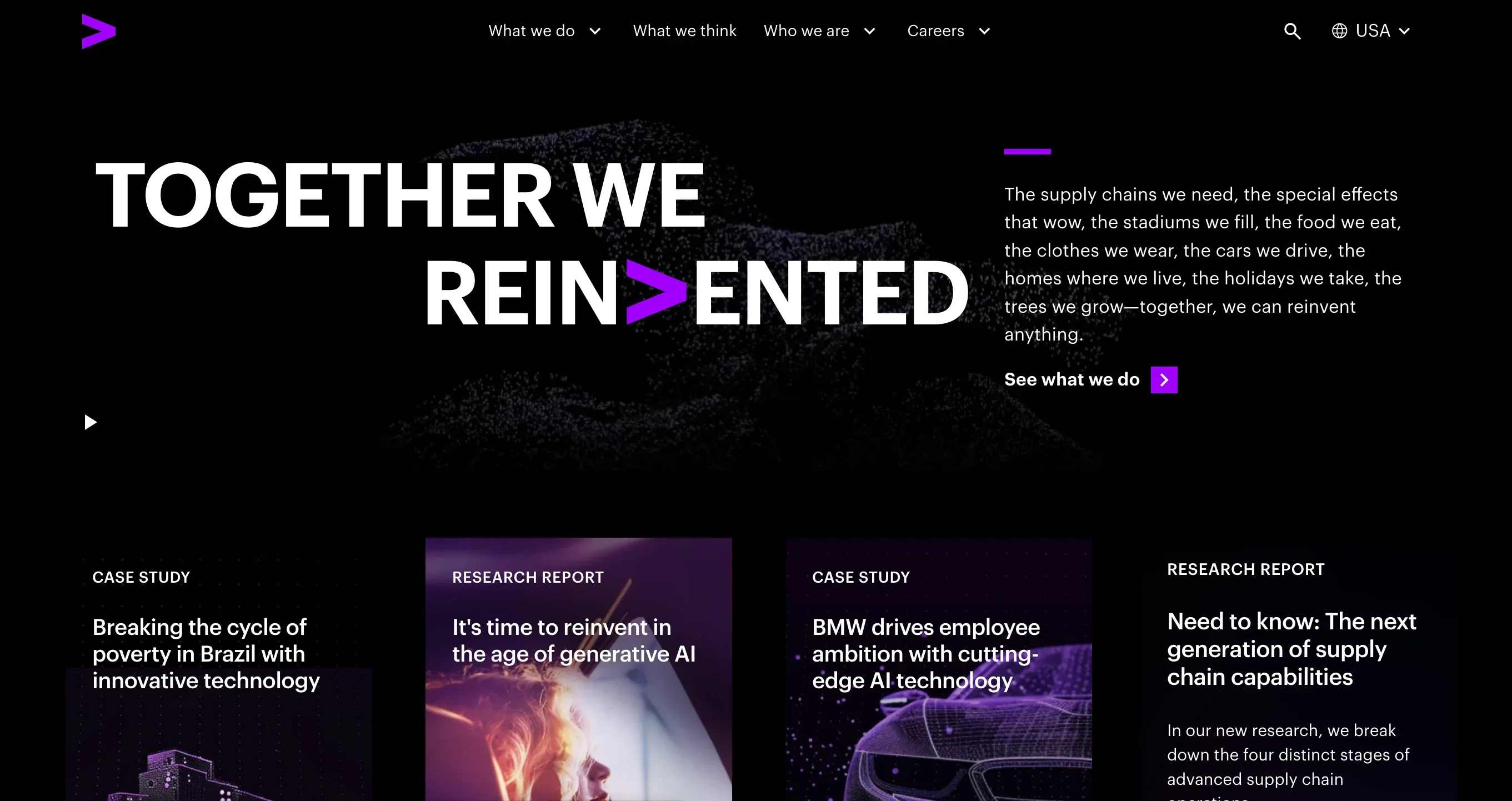
Accenture is a well-known IT company that services small businesses and startups. Its main service offerings include eCommerce development, project management, and software development. Accenture also provides clients with IT integration and upkeep services, which help them overcome the usual challenges and obstacles to achieving speed and agility.
Leveraging their collaborative approach with clients, efficient solutions work for any project scale or size. As a trusted brand globally, Accenture has built a reputation for being a reliable and trusted partner with which to work.
Notable Features of Working with Accenture
- Reliable and Efficient Project Delivery: Accenture utilizes robust project management methodologies to ensure smooth project execution and minimize risks.
- Trusted Industry Brand Name: Accenture's extensive client portfolio includes businesses of all sizes across various industries, showcasing their versatility and experience.
- Responsible Digital Transformation: Accenture takes a holistic approach to digital transformation, considering the impact on people, processes, and technology.
Accenture Price Plans
Accenture offers comprehensive solutions to each client. With an experienced team of professionals working to exceed client expectations, it is best to contact representatives via their website to schedule a consultation call. All estimated quotes by Accenture are available on demand based on your project specifications.
9. Cognizant - IT Outsourcing Solutions for Growing Businesses
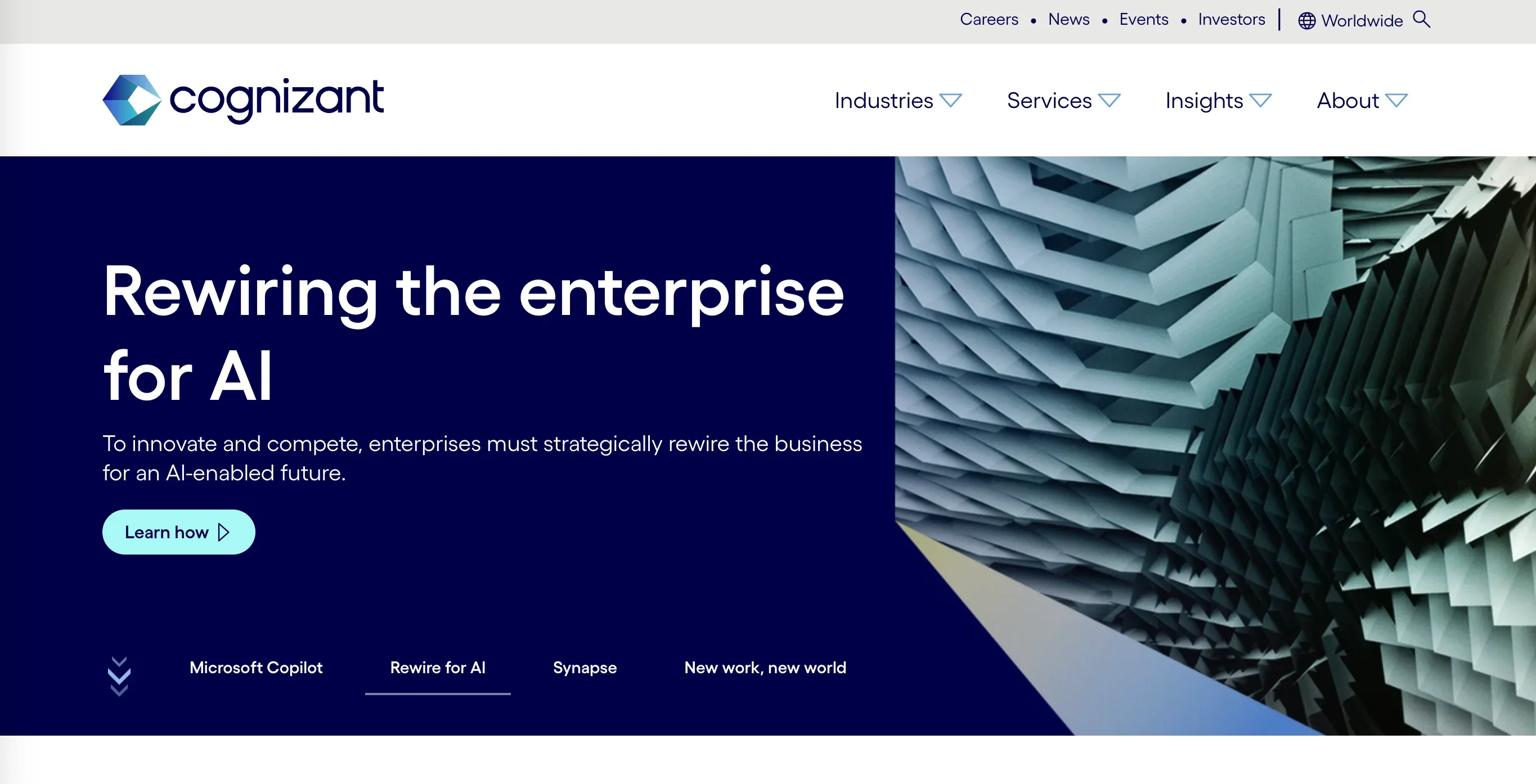
Cognizant focuses on helping companies achieve digital transformation by applying modernized technological approaches. Their team helps clients reinvent their processes to transform experiences, enabling them to stay ahead of the curve in fast-paced business environments.
Among their core strengths is their emphasis on cloud, automation, and data management. Cognizant proves to be a well-equipped partner to work with in handling such areas of IT management. Moreover, their team takes a personalized approach to project management to ensure the best quality results are delivered on time.
Notable Features of Working with Cognizant
- Generative AI Services: Cognizant offers custom AI solutions that leverage data-driven insights to analyze large datasets, providing valuable insights that inform strategic decision-making.
- Business Automation Solutions: By applying robotics process automation and workflow optimization, clients can realize improved speed, accuracy, and overall productivity when it comes to their IT needs.
- Robust Data Management Expertise: With robust data management, their IT outsourcing solutions implant robust data management practices to ensure data quality, compliance, and security.
Cognizant Price Plans
Cognizant has worked with leading brands globally, delivering high-quality results to their business processes. Regardless of business size, type, or industry, Cognizant has a solution that caters to specific requirements. Those looking to work with their team should reach out to their representatives via their website to schedule a consultation call and personalized price estimate.
10. Belitsoft - IT Solutions for Software Development

Belisoft is an offshore software development company that provides a wide range of tech solutions to meet diverse business needs. Specializing in building out IT outsourcing teams, Belitsoft offers comprehensive services to help clients achieve their software development goals efficiently and effectively. Their approach combines deep technical expertise with a commitment to delivering high-quality, tailored solutions.
Notable Features of Working with Belisoft
- Dedicated IT Outsourcing Teams: Belitsoft assembles dedicated teams of highly skilled professionals to meet the specific requirements of each project.
- Tech Strategy and Process Improvement Services: Work with professionals to develop detailed technology roadmaps to guide you through your digital transformation journeys.
- Custom Software Development: Explore their ability to create custom software solutions that cater to your unique needs.
Belisoft Price Plans
Belitsoft offers flexible pricing plans tailored to meet the diverse needs of their clients. Their pricing models are designed to provide value while accommodating various project scopes and budgets. To learn more about price estimates and services, reach out to their representatives through their website.
11. Fujitsu - Dynamic IT Business Roadmaps
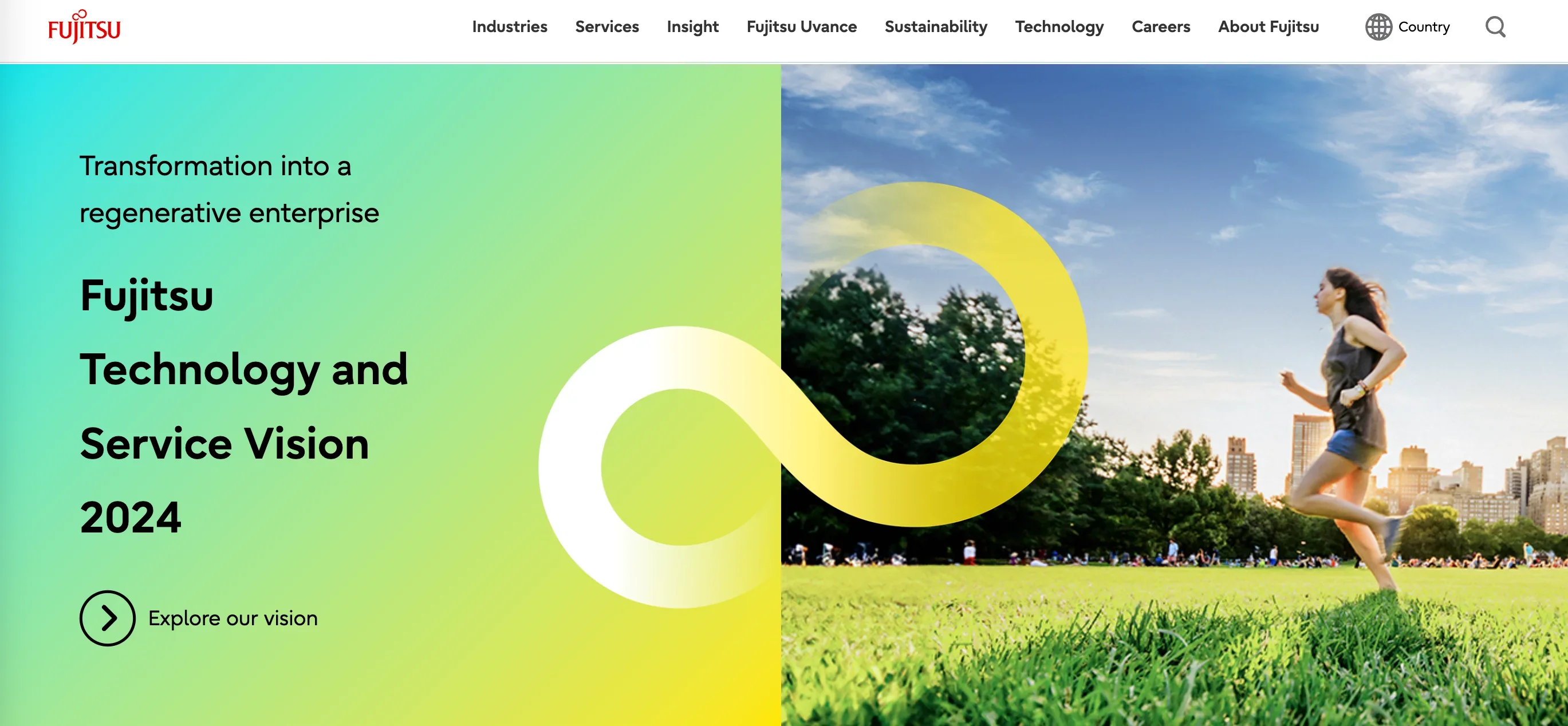
Fujitsu works with clients globally to deliver dynamic IT business roadmaps that place data-driven strategies and outcome-driven processes at the forefront of their collaborations. Their business consultant services also ensure to combine industry expertise with reliable data analytics to solve common business problems and enhance the overall value of a business in the modern age.
Clients that work with Fujitsu and their IT consultancy services can expect to realize process optimization through well thought out plans that cater to a businesses changing needs as it scales and grows in its industry. Applying a Management Consulting Services, clients can also expect to see significant improvements in efficiency, innovation, and competitive advantage.
Notable Features of Working with Fujitsu
- Value Realization Approach: Fujitsu aligns IT initiatives closely with business objectives to ensure value realization. Their team implements measurable goals and performance metrics to track progress and success.
- IT Value Assessments: Work with them to conduct thorough assessments of IT investments and initiatives to assess their impact and effectiveness.
- Business Architecture Consulting: Benefit from designing scalable solutions that support business growth and adapt to changing market demands.
Fujitsu Price Plans
Fujitsu is a strategic partner for businesses seeking dynamic IT business roadmaps and comprehensive consultancy services. Specific pricing details are customized based on the complexity of the project, duration, and desired outcomes, reflecting Fujitsu's commitment to delivering value and ROI. Reach out to their team via their website to schedule a consultation call and get a detailed breakdown of recommended services and prices.
12. Expert Computer Solutions: Premier IT Outsourcing for Cybersecurity

Expert Computer Solutions (ECS) stands asa leader in IT outsourcing, with a strong focus on cybersecurity, serving businesses in Houston, Texas, and beyond. With over 19 years in the industry, the company specializes in providing top-tier cybersecurity solutions that safeguard businesses against emerging threats while maintaining optimal operational efficiency.
Their dedicated team of IT experts is adept at tailoring cybersecurity strategies to fit the unique needs of each client, ensuring robust protection and peace of mind. Beyond cybersecurity, ECS also offers comprehensive services in IT infrastructure management and cloud migration, ensuring a full spectrum of IT support.
Notable Features of Working with Expert Computer Solutions
- Advanced Security Protocols: Utilizing cutting-edge technologies, they provide proactive defenses against cyber threats, ensuring your business's data integrity and security.
- Customized Cybersecurity Strategies: ECS creates tailored cybersecurity solutions to match your specific operational needs, maximizing protection where it matters most.
- Comprehensive IT Services: In addition to cybersecurity, they excel in IT infrastructure management and cloud migration, providing a holistic approach to IT outsourcing.
- Proactive Threat Monitoring: Continuous monitoring and rapid response capabilities keep your business ahead of potential security breaches.
- Regulatory Compliance and Risk Management: ECS’s experts ensure that your cybersecurity measures comply with industry regulations, reducing legal risks and enhancing overall security.
Expert Computer Solutions Price Plans
Expert Computer Solutions offers competitive and flexible pricing models designed to provide high-value cybersecurity and IT services tailored to your specific needs. For more information on their services or to schedule a consultation, visit their website or call their office. Choose Expert ComputerSolutions for comprehensive and reliable IT outsourcing that protects and empowers your business in the digital age.
13. TrinityWired - IT Outsourcing Service for Turnkey Projects

TrinityWired is an IT consulting service solution ideal for turnkey projects and product development initiatives. As a company, they offer a full range of services related to DevOps integration, cloud consulting and system administration, optimized software development, and CI/CD. Clients looking for IT outsourced solutions also benefit from a wide range of professional expertise and service options.
With that, it's easy for clients to build out their IT teams with multifaceted specializations to handle their turnkey projects and initiatives. In turn, businesses can achieve greater engagement with their target audience.
Notable Features of Working with TrinityWired
- Wide Range of Technological Services: Project expansion and updating are easier to manage with TrinityWired's wide range of technological services and software solutions catered to providing a better route for specializations.
- Multiple IT Skill Sets: Clients looking to diversify each project's reach and potential can take full advantage of TrinityWired's varying expertise in different IT skill sets.
- Comprehensive IT Solutions: Make the process of building multifaceted software solutions by utilizing various comprehensive technologies to further improve scalability and growth.
TrinityWired Price Plans
TrinityWired quotes a starting price of $5999 per month for a team of 10+ software engineers for a web app or mobile app development. However, personalized quotes need to be requested directly from the company. Reach out to their representatives through their websites for more details.
How to Choose the Best IT Outsourcing Companies
Discovering the top IT outsourcing companies in today's market is only the first step in partnering with the right team. To ensure you make the most out of the service they provide and achieve your business goals at the same time, here is a quick step-by-step guide to follow:
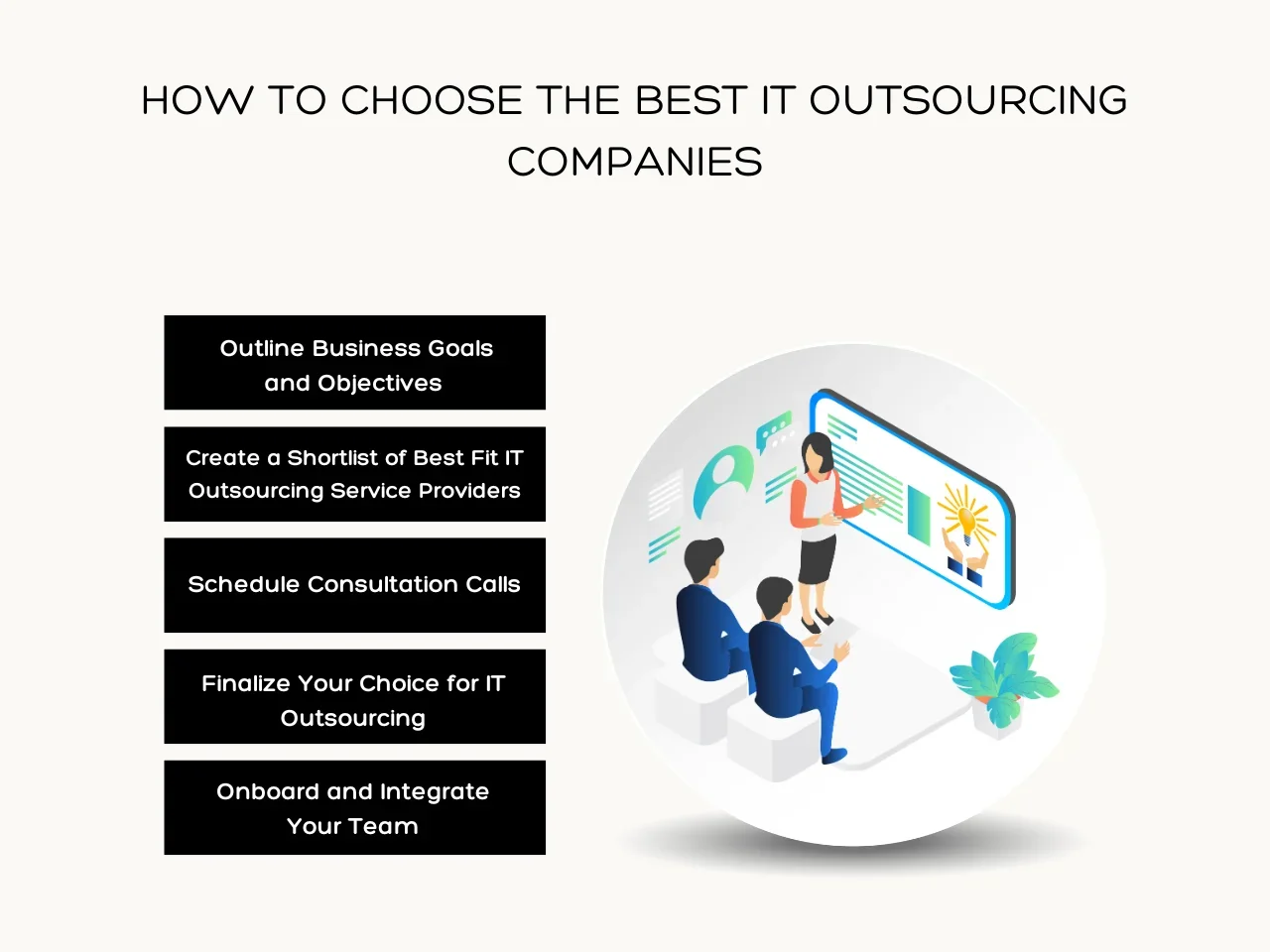
Step 1: Outline Business Goals and Objectives
Before you start exploring the multiple software development options available to you when it comes to the best outsourcing companies, it's best to outline the business goals and objectives you have. As mentioned in the first section there are various types of IT outsourcing services, each one with their own unique benefit and potential outcome.
As a starting point, you can compile your goals and objectives into a project scope document. Project scope documents include general details about the project.
Here are the main details to include when scoping your project:
- Primary Goals: Define the main goals you want to achieve through this project (e.g., improve efficiency, reduce costs, enhance customer experience).
- Project Timeline: Provide an estimated timeline for the project, including start and end dates.
- Key Milestones: Identify significant milestones and their target dates, such as project kickoff, key deliverables, and project completion.
- Project Team: Define the project team, including internal team members and the outsourcing partner's team, with their specific roles and responsibilities.
- Budget: Outline the estimated budget for the project, including costs for outsourcing services, tools, and any other expenses.
- Resources: Identify the internal and external resources needed for the project, such as personnel, technology, and materials.
- Acceptance Process: Define the process for accepting completed deliverables and project outcomes.
Even if these points are not yet final, you'll at least have a basis to follow when working with IT partners and professionals. A project scope can change or be revised as necessary when the time comes.
Step 2: Create a Shortlist of Best Fit IT Outsourcing Service Providers
Taking from the list of the top IT outsourcing companies we provided above, you can explore the specific strengths, expertise, and services each company offers to create a shortlist of potential partners that align with your business needs.
Here's how you can proceed:
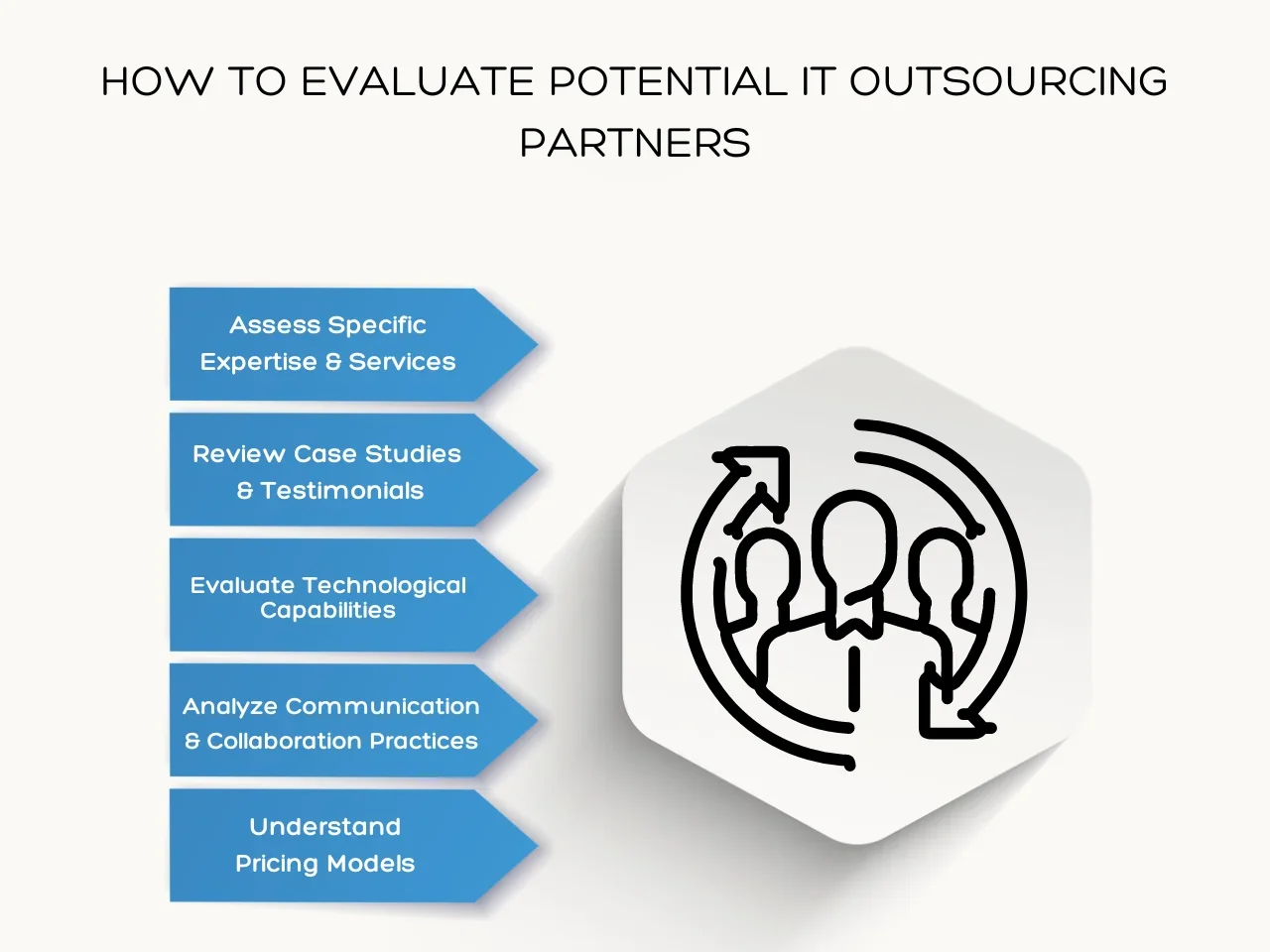
- Assess Specific Expertise and Services: Crafting comprehensive software solutions requires a deep understanding of the fundamentals of maximizing different IT fields. Assessing the individual needs of each project helps pinpoint the appropriate service specializations needed.
- Review Case Studies and Testimonials: IT outsourcing takes careful planning and consideration to ensure that the development progress remains consistent. Examining case studies and testimonials from previous clients can determine the potential working conditions. You can review sites lie Microsoft PL-300 Dumps or PorfPros.
- Evaluate Technological Capabilities: Companies that can take advantage of newer technological innovations can easily improve the scalability potential of each project. Evaluating a company's ability to harness these technological capabilities is crucial for further improvement.
- Analyze Communication and Collaboration Practices: Collaboration between clients and companies can help make the transition smoother while also allowing for a more straightforward opportunity to relay updates and information during project development.
- Understand Pricing Models: Investing in a reputable and reliable IT outsourcing company is a necessity in today's modern age. However, taking note of the different pricing models between similar competitors can help balance costs.
Step 3: Schedule Consultation Calls
Once you have a shortlist of potential IT outsourcing companies to work with, you can begin scheduling consultation calls with each one. These consultation calls should focus on gathering information relevant to your project. The best way to go about this is to keep your project scope in hand and refer to it when it comes to determining whether or not a potential partner is the right choice for you.
Keep in mind the core elements and priorities of your project such as the budget, timeline, team type and size, and required technology experience. These aspects will become the determining factor on whether or not an IT company is the right choice for your IT outsourcing needs.
Step 4: Finalize Your Choice for IT Outsourcing
Having gathered all the information from shortlisted partners and scheduling consultation calls with them to get a better understanding of their services and price estimates, you can finalize which option aligns best with your project. As part of finalizing an IT outsourcing company to work with, you will also need to draw up a contract agreement that outlines the stipulations of your working arrangement.
Step 5: Onboard and Integrate Your Team
Once you have selected the best-fit IT outsourcing service provider, the next critical step is to onboard and integrate the outsourced team effectively. Proper onboarding ensures that both your internal team and the outsourced team are aligned and can work together seamlessly.
Here's how you can ensure a smooth onboarding and integration process:
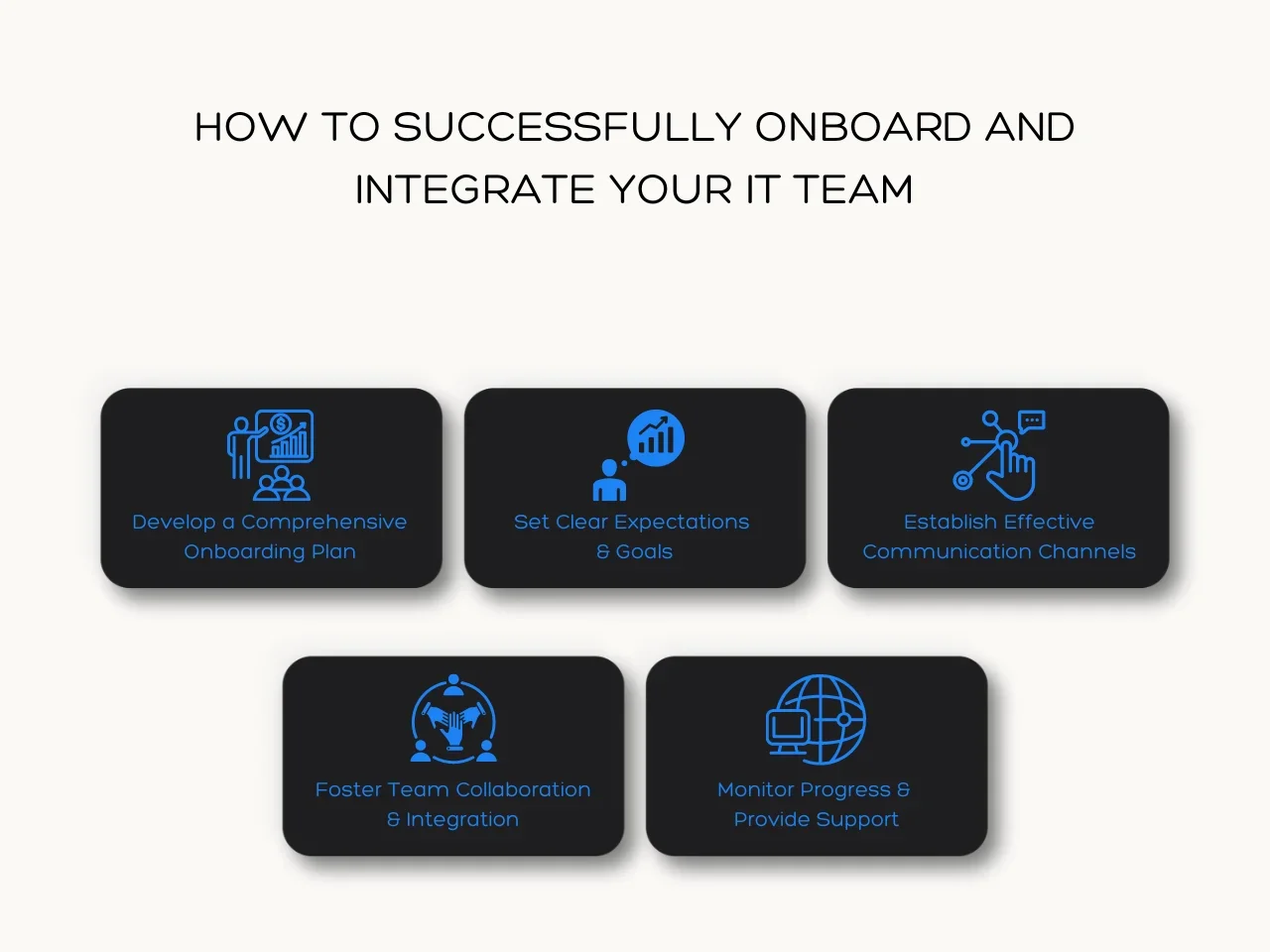
- Develop a Comprehensive Onboarding Plan: Onboarding an entire outsourced team can become complicated if the target goals and objectives are not properly aligned. Crafting a detailed onboarding plan can help ensure that the ease of transition will be easier to manage.
- Set Clear Expectations and Goals: The clearer the expectations set for each outsourced IT developer, the better they will understand the obligations required to accomplish the tasks.
- Establish Effective Communication Channels: Constant open communication encourages both parties to have a safe and reliable platform to voice their concerns and ensure that all aspects of the project's development are relegated to the appropriate individuals.
- Foster Team Collaboration and Integration: Working with a large team alongside outsourced individuals can create a division in the workplace. Fostering effective team collaboration and integration between all tasks helps keep all members included in the overall development.
- Monitor Progress and Provide Support: Effective monitoring is essential to identifying any lingering performance issues. Work with each team member to ensure that they understand their shortcomings and provide effective support to improve their efficiency.
Starting your project implementation with strong onboarding and integration plans ensures a smooth transition, maximizes productivity, and lays the foundation for a successful partnership.
Key Takeaway
IT outsourcing companies today offer a wealth of experience and knowledge in building out and optimizing their clients' ability to innovate and operate efficiently. Partnering with the right company enables businesses to leverage specialized skills, advanced technologies, and proven methodologies to enhance their processes and achieve their strategic goals.
Embracing the expertise of top IT outsourcing companies allows businesses to focus on their core competencies, drive growth, and stay competitive in an ever-evolving market. As a result, businesses can experience increased agility, reduced operational costs, and improved overall performance, paving the way for sustained success and innovation in their industry.
Aloa can help you build your IT team with the best talent in the industry. Email us at [email protected] to schedule a consultation call with our Account Executives. We'll discuss your project scope and connect you with the ideal professionals to address your business goals.

